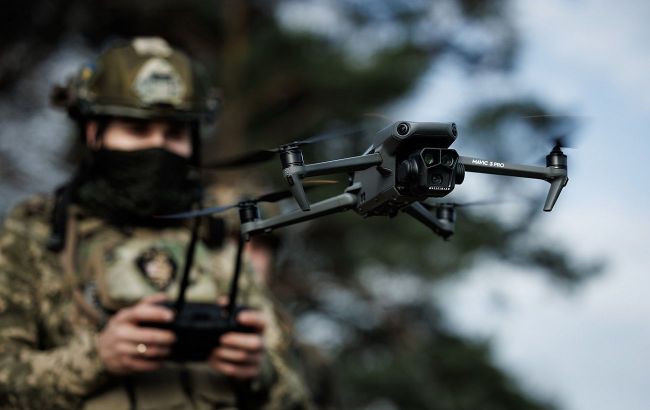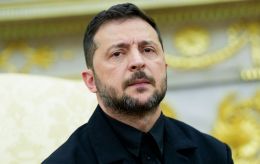China halts Mavic drone sales: Can Ukraine replace Chinese gear before it's too late?
 A Ukrainian soldier from the OPFOR assault battalion with a Mavic 3 drone (Photo: Getty Images)
A Ukrainian soldier from the OPFOR assault battalion with a Mavic 3 drone (Photo: Getty Images)
China's restrictions on drone exports to Ukraine have reached a critical point. Ukrainian forces are increasingly struggling with a shortage of Mavic drones — and could soon be left without them entirely. RBC-Ukraine explores how Chinese drones have become a monopoly in the Russia-Ukraine war and whether there's a way to replace them.
Mavic drones first appeared widely among Ukrainian units around 2017–2018. The Mavic 2 Pro replaced the Mavic Pro Platinum. These newer models were more compact, quieter, and featured improved cameras. They became a "workhorse" on the front line — easy to launch within a minute and quickly transmit target coordinates.
After Russia's full-scale invasion, demand for Mavics surged by dozens of times. Volunteers sourced them from across the world, and the government began purchasing thousands of drones centrally.
In 2023, Ukrainian Prime Minister Denys Shmyhal publicly stated that Ukraine was "buying up to 60% of the world’s Mavic production." The drones were deployed to frontline units in large numbers, enhancing reconnaissance accuracy, artillery targeting, and even facilitating evacuation operations. At their peak, Mavic drones were seen as essential for every rotation at the front.
Shortage of Mavics on the front line
In spring 2025, DJI officially ended production of its Mavic 3 series. It was replaced by a new line — Mavic 4 Pro — unveiled in May. According to the manufacturer, the new models feature enhanced sensors, improved obstacle resistance, and longer flight time. However, it remains unclear whether the Mavic 4 will be supplied to Ukraine.
In May, President Volodymyr Zelenskyy stated that the Chinese-made Mavic is available to Russians but not to Ukrainians. He said China had stopped selling drones to Kyiv and other European countries while continuing shipments to Russia.
The ANTARES drone systems battalion of the Rubizh Brigade began feeling the shortage of Mavics a year ago. According to the unit's Chief of Staff, Samir Makhmudov, it was already clear back then that shipments were being restricted, purchases were becoming more difficult, and deliveries had to be redistributed across different parts of the front.
Mavic remains a key tool for close-range reconnaissance. Ukrainian forces use it to adjust artillery fire, monitor infantry positions, and conduct surveillance. Makhmudov points out that the strength of the Mavic lies in its consistent factory production and its well-established communication system.

The Mavic remains vital for close-range reconnaissance. It is used to adjust artillery fire and conduct surveillance. (Photo: Getty Images)
The Unmanned Systems Forces of the Armed Forces of Ukraine, in a comment to RBC-Ukraine, confirmed that Chinese manufacturers have indeed imposed unofficial restrictions on drone exports.
"They (the restrictions – ed.) have affected the supply of certain commercial UAV models, particularly due to increased delivery times, higher product costs, and the need to implement more complex logistical solutions," they told RBC-Ukraine.
Amid shrinking supplies of Chinese drones, Ukraine's military is looking for solutions on its own. Some units have already begun transitioning to Ukrainian-made quadcopters. According to Samir Makhmudov from the ANTARES battalion, units are managing through the YeBaly system (a point-based reward program officially called Army of Drones Bonus, which tracks and rewards units for destroying Russian personnel and equipment), and are also turning to volunteers for support. The key focus, Makhmudov said, is on drones that can be maintained and scaled under wartime conditions.
Yehor Firsov, Commander of a strike UAV platoon in the 109th Territorial Defense Brigade, also confirmed to RBC-Ukraine that "there are several new analogues from other foreign manufacturers. And we're searching for ways to buy them." In other words, the search for alternatives is happening not only at the command level, but also among small units who are looking for solutions on their own.
To help reduce the problem, the Ministry of Defense of Ukraine launched an initiative allowing brigades to procure drones independently. Ukrainian producers are already capable of manufacturing about 4 million drones per year, and 1.5 million UAVs have already been delivered to frontline troops. Some brigades have purchased drones themselves, but this process has yet to become routine within the military. Defense Minister Rustem Umerov, in a closed-door meeting with journalists, acknowledged the difficulties.
"We're working with our finance department, and we see that not all brigades are spending these funds. Some commanders say, 'Mr. Minister, I have no one to make the purchases.' Others are afraid to spend the money. Some simply don’t know how," Umerov said.
To fix this, the Defense Procurement Agency is introducing DOT-Chain Defense — a kind of "drone marketplace" where each brigade can order what it needs, and the agency covers the payment. At least, that’s how it’s supposed to work. But how it will function in practice remains unclear.

Chinese drone supplies dwindle as Ukrainian forces search for alternatives (photo: Getty Images)
Mavic is still dominant, but a shift to alternatives is underway
Any disruption in logistics for the Defense Forces is a worrying signal, and drones are no exception, says Yaroslav Honchar, head of the NGO Aerorozvidka (Aerial reconnaissance). Still, he does not consider the current restrictions on drone supplies to be a critical issue.
According to him, the Mavic remains one of the best frontline reconnaissance drones. Any shortage of these drones is immediately felt on the battlefield.
The Unmanned Systems Forces also acknowledges that Chinese drones still make up a significant part of the fleet along the front line. However, there is a steady trend toward the rise of Ukrainian drone manufacturers.
Among the alternatives currently being used in the field, Honchar points to Autel drones, although they account for less than 5% of usage compared to Mavic. There are also isolated cases of Ukrainian-made reconnaissance UAVs being deployed, such as the Linza drone, but their numbers remain small. The Unmanned Systems Forces states that platforms like Mamba, Shark, and Valkyrja are already being actively used, with some models considered potential replacements for the Mavic in support and reconnaissance missions.
"The key requirements include resistance to electronic warfare, a flight time of at least 40 minutes in combat conditions, a modular design that allows for sensor replacement and upgrades, a high-quality thermal imaging module, open software architecture for integration into tactical command systems, and ease of deployment and use in field conditions. These criteria form the foundation for the technical specifications of new drone solutions," the Unmanned Systems Forces explained.
When asked whether Western models, such as the Parrot Anafi USA, Skydio X2, or Teal Golden Eagle, had been tested, the Unmanned Systems Forces confirmed that they had. These drones demonstrate high technical quality, but in field conditions, they are expensive, difficult to maintain, and vulnerable in terms of logistics.
The Unmanned Systems Forces believes it makes sense to develop a centralized government program to transition away from Chinese-made drones. Such a program should include trial batch purchases, platform standardization, international support, and efforts to avoid excessive fragmentation in domestic production.
The Ministry of Strategic Industries of Ukraine confirmed to RBC-Ukraine that at least ten analogues of the Chinese DJI Mavic have already been developed domestically. One example is the reconnaissance drone Shmavic. For security reasons, the names of the manufacturing companies are not being disclosed.

Experts say a centralized government program is now needed to transition to drones not made in China (photo: Getty Images)
China drives drone development — but not without growing pains
Vadym Horiushko, Director of VPP Invest, a drone manufacturing company, believes that although the current crisis is painful, it also provides a strong push for growth. In his view, China's actions have effectively forced Ukraine to shift toward domestic production.
"It's bad that this is happening quite rapidly, creating a certain vacuum at the front. However, I believe that in one or two more quarters, we will have achieved full independence from China. In other words, China itself has contributed to the decline of this drone sector. Chinese companies that see themselves strategically in this field are leaving the country and relocating their production to avoid all these restrictions," he told RBC-Ukraine.
Horiushko points to complications in exporting key materials. Chinese customs now block even components, such as tungsten cutters used for carbon processing. Similar issues arose with carbon itself. Despite these challenges, Ukrainian manufacturers are adapting. They are establishing local production of motors and drone bodies and mastering various technologies.
Director of VPP Invest says it is technologically impossible to replicate the DJI Mavic simply. This drone is the product of years of investment and refinement. However, Ukraine is capable of creating a platform that will be more reliable, adaptable, and cost-effective in the long term. According to him, Ukrainian producers are experimenting and evolving, and their drones may soon surpass those of China.
In response to RBC-Ukraine's inquiry, the Ministry of Strategic Industries stated that Ukraine has expanded its support tools for domestic producers. For example, government decrees have exempted drones and their parts from customs duties and VAT. Manufacturers involved in developing the defense industry also receive compensation for their efforts.
"The goal of these changes is to create favorable conditions for developing drones that use optical cable for control and video transmission," the ministry said.
The ministry also noted that Ukraine's drone industry is developing through the state platform Brave1 and the test project Iron Range, where companies can conduct trials in conditions close to combat. Available support includes expert consultations, military feedback, technical expertise, and repeated access to infrastructure for testing their designs.

DJI Mavic is the result of years of investment and refinement (photo: Getty Images)
Impact on strike operations
Although Mavic drones are mainly used for reconnaissance, Ukrainian units have long adapted them for other tasks, particularly dropping munitions at close range. Over time, however, FPV drones have increasingly taken over this role and become the foundation of strike group tactics.
"Mavic drones account for 90% of reconnaissance. They serve as the soldier's 'eyes,'" emphasizes Yehor Firsov. According to him, the restrictions on Chinese quadcopters have had much less impact on strike missions.
At the same time, the FPV segment is partly dependent on China, mainly for electronics and motors. Still, Ukraine has made a breakthrough: at the end of 2024, Vyriy Drone assembled the first FPV drone built entirely from Ukrainian components. This marks a key step toward independence from imports in the most dynamic sector of frontline drone reconnaissance.

